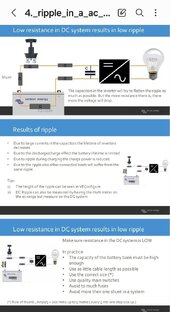You nailed it as far as MY question. To make it more generalized- Is there anything special to be concerned about with an online double conversion UPS vs the transfer-switched approach? Secondary is LFP vs LA in double conversion.
(I am not an EE but I do spend a lot of time looking at various metrics for complex software systems. Also I haven't looked at the schematics, so take this with a grain of salt. FWIW this question can be resolved very quickly if we just find a power engineering PhD student to find the relevant paper, skim for 30 min and give us a summary.)
Keep in mind that you may be applying ideal power source assumptions when analyzing it. And your measurement equipment (the shunts) may not sample quickly enough to detect ripple. So the measurement deficiencies may confirmation-bias/line up with your incomplete assumptions
For instance if the shunt integrates(as in "accumulate it") net DC current over 0.5s I'm pretty sure you'll never see any ripple. The load could draw a few micro-amp-hours from the battery, then the charger pushes that back in, and that still nets to 0. From the shunt on the output of the charger's, it is impossible to know how much of the current went into the battery. Only a shunt on the battery has a chance, if it samples quickly enough.
Transfer switch approach seems seems much easier to eliminate the possibility of charge/discharge ripple on the battery. In that approach, to achieve the lowest transfer time the inverter should be kept spun up but disconnected from the load. This should be a fairly low idle draw that is independent of the load being supported. Some cleverness will need to be done to simultaneously avoid rippling the battery & providing the idle power to the inverter. Maybe a transfer switch on the DC side too to supply the inverter in standby mode directly from the charger without also having the battery in the circuit.
If you have online double conversion, where there are no AC relays and switching from grid to inverter power, then you have to start worrying about the battery/inverter/charger all pushing and pulling against each other. And you can't simplify this away by isolating the battery, because that would may increase the transfer time.
Now if you do something like constantly cycle the battery (EG, it's never in float, you are always either off charger or charging at a high enough current to serve any inverter load that comes on), you can see that ripple is impossible to happen. But you are putting cycles on the battery.
If a 12V pack's resting voltage is 13.3x then setting the storage stage somewhere around 13.3 will mean that no current is pulled until and except when the load comes online and then it will mostly or completely pass through as needed if available.
This makes sense for ideal power supplies but real power supplies do not react instantaneously. I would expect a LFP battery to be stiffer than a charger/power supply, since the batteries are natively providing some voltage without the need for fancy circuitry.
The charger is a switched-mode power supply (SMPS) and it literally synthesizes the output voltage / current with a controller governing the switching/pumping of power across itself. This will need to adjust as the demand increases/decreases.
So suppose battery is in float. UPS load is idle. The SMPS only has to pump a small amount of energy through to maintain the float voltage (parasitic losses + the idle draw of the UPS inverter).
For concrete scenario, think of server sitting idle waiting for a request (5W). And then it gets sent a request that requires running some program on the GPU (200W). On 12V battery that is 0.5A in the initial state and 16A in the second state.
Going from 0.5A to 16A on the battery is instant, because it's a battery and can react with just chemistry. On the SMPS, there will be some electronic logic involved.
Now, if all we have to worry about with ripple is this kind of transient, then maybe it's less important to worry about.
---
To sort of summarize. I think ripple is intrinsically a challenge to the simplified ideal charger / power source model (intellectual challenge - it does not happen if you idealize the components enough). And then beyond that, I think there are multiple kinds of potentially relevant ripples.
1) Above, I mentioned one that operates at slow time scales and when the system switches between different steady state current draw.
2) There is also the faster timescale of the multiple SMPSs in the system. The charger is a switch mode devices, and the inverter is also a switch mode device. And in steady state with no change in current draw from the load on the output of the UPS, the inverter will be pulling from the charger's output at a khz frequency, and the smps reactively adjusts how it pushes back, also at a khz frequency. The charger is effectively a parallel power source to the battery so we would need to do circuit analysis or simulations to see how the two share the high frequency changes in load.
If there is good filtering on the charger, maybe it can supply more of the power than the battery.




